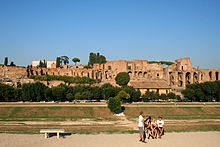- House of Augustus
-
The House of Augustus, or the Domus Augusti, is the first major site upon entering the Palatine Hill in Rome, Italy. It served as the primary residence of Caesar Augustus during his reign. The Domus Augusti should not be confused with the Domus Augustana (also known as the Domus Augustiana), which is a part of the vast palatial complex constructed by Emperor Domitian on the Palatine in 92 AD, of which the Domus Flavia is a part.[1]
Contents
Construction
After being awarded tribunica potestas for life in 23 BC, Octavian decided to buy the house of Quintus Hortensius on the Palatine and make his primary place of residence.[2] The comparative modesty of the Domus Augusti was in keeping with the return to traditional ideals promoted during the Augustan period, as indicated by Suetonius in the quote below. The Domus Augusti was located near the Hut of Romulus and other sacred sites which relate to the foundation of Rome. In antiquity this residence contained two levels, each leading to a garden courtyard. The bottom floor is not accessible today, but it is possible to make out the basin of a fountain and the rooms beyond it that were paved in coloured marble. [3]
The Domus Augusti in Contemporary Times
Suetonius (c. 70 AD – after 130 AD), lawyer and secretary of the imperial palace, wrote of Augustus and his palace:
It is generally agreed that he was most temperate and without even the suspicion of any fault. He lived at first near the Forum Romanum, afterwards on the Palatine in a modest dwelling remarkable neither for size or elegance, having but a short colonnade with columns of local stone and rooms without any marble decorations or handsome pavements. For more than 40 years he used the same bedroom in winter and summer.[4]
Later History
According to L. Richardson, Jr.'s A New Topographical Dictionary of Ancient Rome, "The house burned, perhaps in AD 3, but was then rebuilt (Suetonius, Aug. 72.2.) and, made state property (Cass. Dio 55.12.4-5). Suetonius speaks of it in the past tense, so it may be presumed that it burned during the fire of Nero. It has recently been identified as a house northwest of the Temple of Apollo, between this and the Scalae Caci," (p.118).[5]
References
- ^ Richardson, Lawrence. "Domus Augstana" From A New Topographical Dictionary of Ancient Rome. Baltimore: Johns Hopkins UP, 1992. Print.
- ^ Tomei, Maria Antonietta. The Palatine. Trans. Luisa Guarneri Hynd. Milano: Electa, 1998. Print.
- ^ [Simonis, Damien. Lonely Planet Italy. 8th ed. Oakland: Lonely Planet Publications Pty Ltd, 2008.]
- ^ [Suetonius. Augustus 72.1]
- ^ Richardson, Lawrence. A New Topographical Dictionary of Ancient Rome. Baltimore: Johns Hopkins UP, 1992. Print.
Coordinates: 41°53′18″N 12°29′13″E / 41.88833°N 12.48694°E

This Ancient Rome-related article is a stub. You can help Wikipedia by expanding it.

